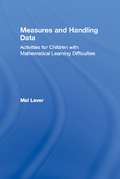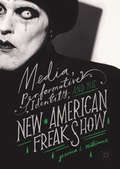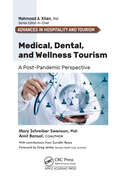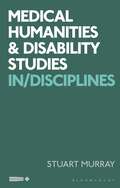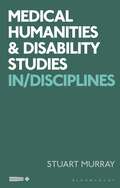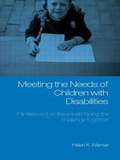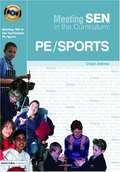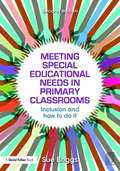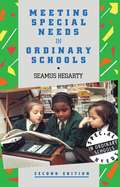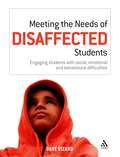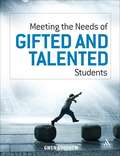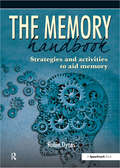- Table View
- List View
Measures and Handling Data: Activities for Children with Mathematical Learning Difficulties
by Mel LeverFirst Published in 2003. Routledge is an imprint of Taylor & Francis, an informa company.
Media, Performative Identity, and the New American Freak Show
by Jessica L. WilliamsThis book traces how the American freak show has re-emerged in new visual forms in the 21st century. It explores the ways in which moving image media transmits and contextualizes, reinterprets and appropriates, the freak show model into a “new American freak show.” It investigates how new freak representations introduce narratives about sex, gender, and cultural perceptions of people with disabilities. The chapters examine such representations found in horror films, including a prolonged look at Freaks (1932) and The Texas Chainsaw Massacre (1974), documentaries such as Murderball (2005) and TLC’s Push Girls (2012-present), disability pornography including the pornographic documentary Sick: The Life and Death of Bob Flanagan Supermasochist (1997), and the music icons Marilyn Manson and Lady Gaga in their portrayals of disability and freakishness. Through this book we learn that the visual culture that has emerged takes the place of the traditional freak show but opens new channels of interpretation and identification through its use of mediated images as well as the altered freak-norm relationship that it has fostered. In its illumination of the relationship between normal and freakish bodies through different media, this book will appeal to students and academics interested in disability studies, gender studies, film theory, critical race theory, and cultural studies.
Media, Performative Identity, and the New American Freak Show
by Jessica L. WilliamsThis book traces how the American freak show has re-emerged in new visual forms in the 21st century. It explores the ways in which moving image media transmits and contextualizes, reinterprets and appropriates, the freak show model into a “new American freak show.” It investigates how new freak representations introduce narratives about sex, gender, and cultural perceptions of people with disabilities. The chapters examine such representations found in horror films, including a prolonged look at Freaks (1932) and The Texas Chainsaw Massacre (1974), documentaries such as Murderball (2005) and TLC’s Push Girls (2012-present), disability pornography including the pornographic documentary Sick: The Life and Death of Bob Flanagan Supermasochist (1997), and the music icons Marilyn Manson and Lady Gaga in their portrayals of disability and freakishness. Through this book we learn that the visual culture that has emerged takes the place of the traditional freak show but opens new channels of interpretation and identification through its use of mediated images as well as the altered freak-norm relationship that it has fostered. In its illumination of the relationship between normal and freakish bodies through different media, this book will appeal to students and academics interested in disability studies, gender studies, film theory, critical race theory, and cultural studies.
Medical Aspects of Autism and Asperger Syndrome: A Guide for Parents and Professionals
by Mohammad GhaziuddinPeople with autism are at a higher risk of having additional medical conditions, so increased care should be taken to ensure any other needs are detected early and effectively managed. This book is the perfect aid for doing so, providing detailed information on the range of possible further conditions, including epilepsy, eating disorders or genetic conditions. Written for both parents and practitioners, including students, it shows how these medical conditions can be identified, and explains the range of possible treatments that are available that may improve the quality of life of the affected person.
Medical, Dental, and Wellness Tourism: A Post-Pandemic Perspective (Advances in Hospitality and Tourism)
by Mary Schreiber Swenson Amit BansalMedical, Dental, and Wellness Tourism: A Post-Pandemic Perspective offers a thorough and informative guide to medical travel and tourism for the treatment of health-related issues. The book first defines medical, dental, and wellness tourism and travel for treatment and then goes on to look at the myriad issues involved, such as benefits and challenges of travel for treatment, how the COVID-19 pandemic has affected the treatment sectors in tourism, selecting the right destination and facility, ending your life in another country, the growing world of birth tourism, dental tourism, medical travel for second opinions, privacy and health data security, the importance of post-operative care, and more. The book explores why medical tourism is the answer to our healthcare crisis. The patient deserves the right to seek the highest quality of medical, dental and wellness care anywhere on the globe with transparent pricing. This volume provides an abundance of information necessary for practical solutions to healthcare needs, both to avoid the seemingly ever-rising cost of healthcare in the United States, offering choices and options outside the US as well as for choosing effective care in other countries. The volume also addresses advances in technology in the healthcare travel industry. A section on resources and experiences to aid in making the right healthcare decisions is included as well. The chapters answer important questions when considering healthcare outside the US, such as What options and choices are available globally How to choose the right medical, dental, pharma, or wellness location The benefits and challenges of travel for treatment What is involved in euthanasia in other countries How privacy of healthcare data maintained COVID-19 has changed the face of the globe. Patients have a new perspective on how they want to receive health and wellness care, and this includes a deeper dive into the world of medical, dental, and wellness tourism. The future is about customizing how and where the patient wants to receive their medical, dental, and wellness treatments, transparent pricing, and the ability to make choices and view options anywhere in the world. Employers, government agencies, and private organizations are able to control healthcare costs, forecast trends, and allow their employees to get the highest quality of care through specialized Centers of Excellence. The book offers a comprehensive guide to medical, dental, and wellness tourism, explains how technology plays a role, as well as proposes solutions to the current healthcare system. A must read for anyone interested in the future of our global healthcare system. Written by a renowned international speaker on medical, dental, and wellness tourism and travel for treatment, who has significant experience and advocate for affordable healthcare choices, this volume shares necessary information for those considering healthcare in other countries-those needing care as well as their healthcare professionals and loved ones.
Medical, Dental, and Wellness Tourism: A Post-Pandemic Perspective (Advances in Hospitality and Tourism)
by Mary Schreiber Swenson Amit BansalMedical, Dental, and Wellness Tourism: A Post-Pandemic Perspective offers a thorough and informative guide to medical travel and tourism for the treatment of health-related issues. The book first defines medical, dental, and wellness tourism and travel for treatment and then goes on to look at the myriad issues involved, such as benefits and challenges of travel for treatment, how the COVID-19 pandemic has affected the treatment sectors in tourism, selecting the right destination and facility, ending your life in another country, the growing world of birth tourism, dental tourism, medical travel for second opinions, privacy and health data security, the importance of post-operative care, and more. The book explores why medical tourism is the answer to our healthcare crisis. The patient deserves the right to seek the highest quality of medical, dental and wellness care anywhere on the globe with transparent pricing. This volume provides an abundance of information necessary for practical solutions to healthcare needs, both to avoid the seemingly ever-rising cost of healthcare in the United States, offering choices and options outside the US as well as for choosing effective care in other countries. The volume also addresses advances in technology in the healthcare travel industry. A section on resources and experiences to aid in making the right healthcare decisions is included as well. The chapters answer important questions when considering healthcare outside the US, such as What options and choices are available globally How to choose the right medical, dental, pharma, or wellness location The benefits and challenges of travel for treatment What is involved in euthanasia in other countries How privacy of healthcare data maintained COVID-19 has changed the face of the globe. Patients have a new perspective on how they want to receive health and wellness care, and this includes a deeper dive into the world of medical, dental, and wellness tourism. The future is about customizing how and where the patient wants to receive their medical, dental, and wellness treatments, transparent pricing, and the ability to make choices and view options anywhere in the world. Employers, government agencies, and private organizations are able to control healthcare costs, forecast trends, and allow their employees to get the highest quality of care through specialized Centers of Excellence. The book offers a comprehensive guide to medical, dental, and wellness tourism, explains how technology plays a role, as well as proposes solutions to the current healthcare system. A must read for anyone interested in the future of our global healthcare system. Written by a renowned international speaker on medical, dental, and wellness tourism and travel for treatment, who has significant experience and advocate for affordable healthcare choices, this volume shares necessary information for those considering healthcare in other countries-those needing care as well as their healthcare professionals and loved ones.
Medical Humanities and Disability Studies: In/Disciplines (Critical Interventions in the Medical and Health Humanities)
by Stuart MurrayMedical humanities and disability studies are disciplines at the cutting edge of innovative critical work in the study of health and disability, but to date there has been no book-length examination of the relationship between the two. Although each has emerged from different heritages, they share many features, from discussing the complexities of embodiment, identifying processes of exclusion and championing user participation, to a commitment to new forms of critical writing. In/Disciplines explores the connections between the two disciplines in detail. It presents a series of provocations about how they interact, the forms their practice take, and their strengths and weaknesses as working methods. With a focus on life stories that give accounts of health and disability experiences, it mixes creative and critical writing in an accessible manner aimed at a wide audience in both Medical Humanities and Disability Studies, and across new humanities more widely. The book asserts that both disciplines need to evaluate and challenge core assumptions if they are to remain critically relevant in the evolving study of social and cultural understanding of health and disability.
Medical Humanities and Disability Studies: In/Disciplines (Critical Interventions in the Medical and Health Humanities)
by Stuart MurrayMedical humanities and disability studies are disciplines at the cutting edge of innovative critical work in the study of health and disability, but to date there has been no book-length examination of the relationship between the two. Although each has emerged from different heritages, they share many features, from discussing the complexities of embodiment, identifying processes of exclusion and championing user participation, to a commitment to new forms of critical writing. In/Disciplines explores the connections between the two disciplines in detail. It presents a series of provocations about how they interact, the forms their practice take, and their strengths and weaknesses as working methods. With a focus on life stories that give accounts of health and disability experiences, it mixes creative and critical writing in an accessible manner aimed at a wide audience in both Medical Humanities and Disability Studies, and across new humanities more widely. The book asserts that both disciplines need to evaluate and challenge core assumptions if they are to remain critically relevant in the evolving study of social and cultural understanding of health and disability.
Meeting The Needs Of Children With Disabilities: Families And Professionals Facing The Challenge Together
by Helen K. Warner Kay HutchfieldThis textbook provides the reader with an insight into the needs of children with both physical and learning disabilities, particularly within an acute care setting. It considers the principles that underpin the fundamental aspects of care delivery to children with special needs. The key areas of knowledge and practical skills covered include: the social and historical context challenging assumptions best practice for giving news to parents communication methods play and movement nutrition and feeding boundary setting respite care transitions into adult services. This interesting book covers practice areas identified by the English National Board as essential for student nurses. It will also be invaluable for qualified nurses and for other health professionals working with children with disabilities.
Meeting The Needs Of Children With Disabilities: Families And Professionals Facing The Challenge Together (PDF)
by Helen K. Warner Kay HutchfieldThis textbook provides the reader with an insight into the needs of children with both physical and learning disabilities, particularly within an acute care setting. It considers the principles that underpin the fundamental aspects of care delivery to children with special needs. The key areas of knowledge and practical skills covered include: the social and historical context challenging assumptions best practice for giving news to parents communication methods play and movement nutrition and feeding boundary setting respite care transitions into adult services. This interesting book covers practice areas identified by the English National Board as essential for student nurses. It will also be invaluable for qualified nurses and for other health professionals working with children with disabilities.
Meeting SEN in the Curriculum: PE and Sports
by Crispin AndrewsMeeting the needs of pupils with SEN on the sports field and in the gym or swimming pool can be very challenging for non-specialist teachers-they need help. This book describes strategies which are practical and effective in mainstream settings. Case studies exmplify good practice in situations involving pupils with a wide range of special needs- from physical difficulties (what does a wheel-chair user do while everyone else plays rugby?) - to communication difficulties and cognitive problems.
Meeting SEN in the Curriculum: Citizenship (Addressing SEND in the Curriculum)
by Alan CombesTeachers are meeting more pupils with special needs in mainstream classrooms and although there are general issues to be aware of, subject specialists will always want specific guidance and examples. This series combines SEN expertise with subject knowledge to produce practical and immediate support including: Policy writing and how to do it; Simple explanations of SEN labels; Creating an inclusive classroom environment; Monitoring and assessment; Working with TAs.
Meeting SEN in the Curriculum: ICT
by Sally McKeownThis book includes: an explanation of the Government's inclusion/SEN strategy guidance on Departmental Policy an explanation of SEN terminology advice on creating an inclusive environment choosing the right hardware and software helpful case studies highlighting different uses of computer packages meeting the needs of different learning styles CD-ROM.
Meeting SEN in the Curriculum: ICT (Addressing Send In The Curriculum Ser.)
by Sally McKeownThis book includes: an explanation of the Government's inclusion/SEN strategy guidance on Departmental Policy an explanation of SEN terminology advice on creating an inclusive environment choosing the right hardware and software helpful case studies highlighting different uses of computer packages meeting the needs of different learning styles CD-ROM.
Meeting SEN in the Curriculum: Citizenship (Addressing SEND in the Curriculum)
by Alan CombesTeachers are meeting more pupils with special needs in mainstream classrooms and although there are general issues to be aware of, subject specialists will always want specific guidance and examples. This series combines SEN expertise with subject knowledge to produce practical and immediate support including: Policy writing and how to do it; Simple explanations of SEN labels; Creating an inclusive classroom environment; Monitoring and assessment; Working with TAs.
Meeting Special Educational Needs In Primary Classrooms: Inclusion And How To Do It (PDF)
by Sue BriggsThere are greater numbers of children with Special Educational Needs and Disabilities (SEND) now attending mainstream schools. This fully updated and revised edition of Meeting Special Educational Needs in Primary Classrooms is written by an experienced teacher, adviser and SEN consultant and explains the challenges that these children face. This is a practical book full of guidance for teachers and teaching assistants who support children with SEND in mainstream primary classrooms. Now fully updated to include the requirements of the 2014 Children and Families Act and SEND Code of Practice, this book: contains photocopiable resources and templates promotes successful communication between teachers, parents and students covers all aspects of teaching children with SEND, including planning, teaching and learning. With practical guidance on how to make the curriculum more accessible for children with SEND, this book will help teachers and TAs work together to support pupils with Special Educational Needs and Disabilities more effectively.
Meeting Special Needs in Ordinary Schools: An Overview
by Seamus HegartyHow can ordinary schools cope with pupils with special needs? What must they do to move beyond the rhetoric of the integration to effective practical action? Seamus Hegarty aims to provide a comprehensive overview of the key issues in the UK. The National Curriculum, local management of schools, changes in teacher training, the role of parents - are discussed and related to day-to-day realities.
Meeting the Learning Needs of All Children: Personalised Learning in the Primary School
by Joan DeanPersonalized learning involves helping each child to reach his or her full potential - intellectually, personally and socially. To achieve this, teachers need to match learning opportunities to the learning styles and experiences of the children, taking into account individual differences in culture, language, background, ability and interests.For
Meeting the Learning Needs of All Children: Personalised Learning in the Primary School
by Joan DeanPersonalized learning involves helping each child to reach his or her full potential - intellectually, personally and socially. To achieve this, teachers need to match learning opportunities to the learning styles and experiences of the children, taking into account individual differences in culture, language, background, ability and interests.For
Meeting the Needs of Disaffected Students: Engaging students with social, emotional and behavioural difficulties (Meeting the Needs)
by Dave VizardThrough the use of a variety of approaches and techniques, including emotional literacy, NLP and learning styles, this resource gives practical examples of how to engage disaffected students and ensure they have a successful learning experience.The book outlines the causes of disaffection generally and looks at a range of syndromes and conditions that may give rise to disaffection, offering support strategies that will encourage the engagement of such students. The book also outlines approaches for helping students to self-manage their behaviour and learning.
Meeting the Needs of Gifted and Talented Students (Meeting the Needs)
by Gwen GoodhewThis introductory guide for class teachers in primary and secondary schools looks at current strategies for identifying able, gifted and talented children and meeting their social, emotional and educational needs. Illustrated throughout with case studies and FAQs, the book will also be of interest to PGCE students, G&T coordinators and those undergoing training as leading teachers.
The Memory and Processing Guide for Neurodiverse Learners: Strategies for Success
by Alison PatrickArmed with the wealth of understanding and strategies in this guide, students will discover how they can learn best, to make studying and revision more effective (and less stressful).Packed with simple, tried and tested strategies and workarounds, this study guide for supporting kids and teens who learn differently (such as those with ADHD, dyslexia, dyspraxia or ASD) explains what memory and processing issues are, and how to work around them. Written by a tutor and specialist with years of experience of working with students with learning differences, this book enables the student to understand the best ways they learn and the reasons behind this. Unpacking processing speed, sensory processing, metacognition, and executive functioning, including working memory, this uniquely relatable and empowering study guide will provide students with the self-understanding they need to manage exams and academic tasks at school with confidence and peace of mind.
The Memory Handbook: Strategies and Activities to Aid Memory
by Robin DynesThis is a handbook full of practical ideas to use with anyone who is experiencing mild to severe memory difficulties. The suggestions and activities can be used when working with individuals or groups. The strategies can, in fact, be used by anyone young or old, who has become worried about loss of memory. The handbook provides: information about how memory works and different types of memory; an outline of what can affect memory; strategies to aid memory; activities to practice using the strategies; and activities to keep the brain active and maintain memory. The resource is aimed at staff in care environments such as residential homes, day centres, social clubs, support groups, carers or anyone who might be concerned about loss of memory. It promotes understanding about memory difficulties and provides a wide range of strategies and activities to aid response to individual need. Approximately 200pp; A4 wire-o-bound.
The Memory Handbook: Strategies and Activities to Aid Memory
by Robin DynesThis is a handbook full of practical ideas to use with anyone who is experiencing mild to severe memory difficulties. The suggestions and activities can be used when working with individuals or groups. The strategies can, in fact, be used by anyone young or old, who has become worried about loss of memory. The handbook provides: information about how memory works and different types of memory; an outline of what can affect memory; strategies to aid memory; activities to practice using the strategies; and activities to keep the brain active and maintain memory. The resource is aimed at staff in care environments such as residential homes, day centres, social clubs, support groups, carers or anyone who might be concerned about loss of memory. It promotes understanding about memory difficulties and provides a wide range of strategies and activities to aid response to individual need. Approximately 200pp; A4 wire-o-bound.
Mental Capacity Casebook: Clinical Assessment and Legal Commentary
by Tracey Ryan-MorganThe Mental Capacity Act 2005 (MCA) provides a legal framework for acting on behalf of individuals who lack the capacity to make decisions for themselves. The Mental Capacity Casebook showcases numerous real-life case studies in accordance to this Act. Through the exploration of various mental capacity assessments, this book highlights the psychological needs of the individuals who are supported and protected by the MCA. Dr. Tracey Ryan-Morgan, a Consultant Clinical Neuropsychologist, is the first to bridge the gap between the individual’s psychological requirements and the legal framework surrounding them. Not only does this book present true, often complex, mental capacity assessments, it does so with legitimate corresponding commentaries. Each case outlines the presented problem along with its background, social context, psychological matters, the overriding opinion and concluding learning points. This book provides a unique standpoint, offering insight into the complexities of the Act and practical guidance on how to conduct assessments. It serves as essential reading for those looking for guidance whilst making complex capacity decisions, such as Clinical Neuropsychologists, Social Workers, and Legal Professionals.
